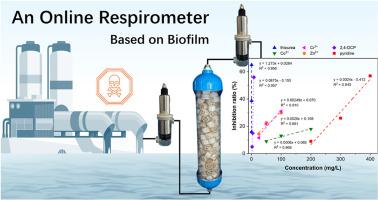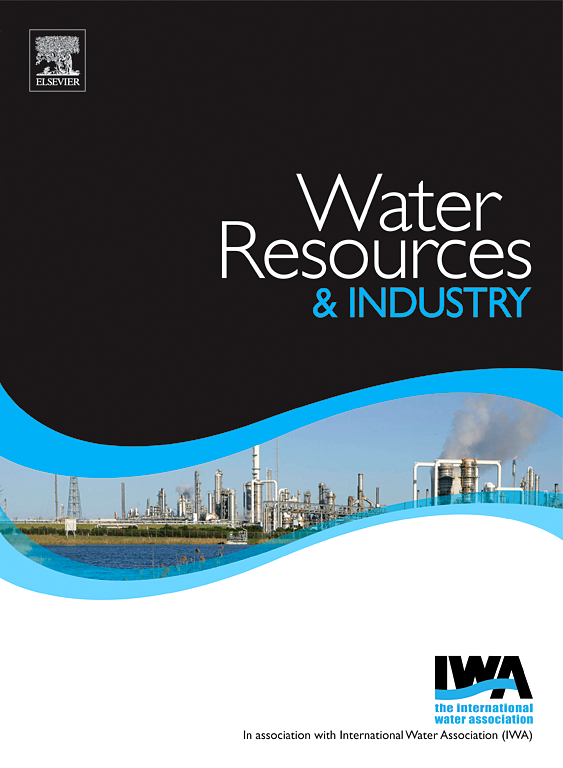An online respirometer based on ammonia oxidizing biofilm for prompt toxicity analysis
IF 7.5
3区 工程技术
Q1 WATER RESOURCES
引用次数: 0
Abstract
Wastewater toxicity may significantly disturb the performance of activated sludge processes, the core unit of most wastewater treatment plants, and thus needs to be monitored. The frequently used respirometer with suspended microorganisms is faced with problems of microbial stability and sensitivity. In this study, we designed an online respirometer with ammonia oxidizing biofilm growing in a fixed bed reactor. The toxicity of typical substances (thiourea, 2,4-dichlorophenol, pyridine, Zn2+, Co2+, Cr6+) was measured with the reduction and the reducing trend of their oxygen uptake rates as a key indicator. The detection limits can be down to 1.25 mg/L for thiourea and 25 mg/L for Zn2+ with measuring time down to 10 min. The IC50 of thiourea, 2,4-dichlorophenol, pyridine, Zn2+, Co2+, Cr6+observed at 0.37 mg/L, 7.42 mg/L, 378 mg/L, 168 mg/L, 191 mg/L 733 mg/L, respectively. The toxicity values were in a good linear correlation with the traditional raspatory. Moreover, the regeneration time of biofilm after toxicity measure of 5 mg/L 2,4-dichlorophenol and 100 mg/L Zn2+ was also evaluated in range of 6–24 h.

基于氨氧化生物膜的即时毒性分析在线呼吸计
活性污泥是大多数污水处理厂的核心单元,废水毒性可能会严重干扰活性污泥工艺的性能,因此需要对其进行监测。常用的悬浮微生物呼吸计面临着微生物稳定性和灵敏度的问题。在本研究中,我们设计了一种在固定床反应器中生长氨氧化生物膜的在线呼吸计。以典型物质(硫脲、2,4-二氯酚、吡啶、Zn2+、Co2+、Cr6+)的吸氧速率的还原率及其还原趋势为关键指标,测定其毒性。硫脲的检出限可达1.25 mg/L, Zn2+的检出限可达25 mg/L,检测时间可达10 min。硫脲、2,4-二氯苯酚、吡啶、Zn2+、Co2+、Cr6+的IC50分别为0.37 mg/L、7.42 mg/L、378 mg/L、168 mg/L、191 mg/L和733 mg/L。毒性值与传统浓度呈良好的线性相关。测定了5 mg/L 2,4-二氯苯酚和100 mg/L Zn2+对生物膜的毒性作用,在6 ~ 24 h范围内对生物膜的再生时间进行了评价。
本文章由计算机程序翻译,如有差异,请以英文原文为准。
求助全文
约1分钟内获得全文
求助全文
来源期刊

Water Resources and Industry
Social Sciences-Geography, Planning and Development
CiteScore
8.10
自引率
5.90%
发文量
23
审稿时长
75 days
期刊介绍:
Water Resources and Industry moves research to innovation by focusing on the role industry plays in the exploitation, management and treatment of water resources. Different industries use radically different water resources in their production processes, while they produce, treat and dispose a wide variety of wastewater qualities. Depending on the geographical location of the facilities, the impact on the local resources will vary, pre-empting the applicability of one single approach. The aims and scope of the journal include: -Industrial water footprint assessment - an evaluation of tools and methodologies -What constitutes good corporate governance and policy and how to evaluate water-related risk -What constitutes good stakeholder collaboration and engagement -New technologies enabling companies to better manage water resources -Integration of water and energy and of water treatment and production processes in industry
 求助内容:
求助内容: 应助结果提醒方式:
应助结果提醒方式:


